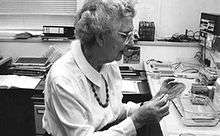Patricia H. Clarke
Patricia Hannah Clarke FRS[1] (née Green) (29 July 1919 – 28 January 2010) was a British biochemist.[2][3]
Patricia Clarke | |
|---|---|
 Patricia Clarke | |
| Born | Patricia Hannah Green 29 July 1919 |
| Died | 28 January 2010 (aged 90) |
| Alma mater | University of Cambridge |
| Spouse(s) | Michael Clarke ( m. 1940) |
| Children | 2 |
| Awards |
|
| Scientific career | |
| Fields | Biochemistry |
| Institutions | University College London |
Education and early life
Clarke was born in Pontypridd, South Wales, and was educated at Howell's School, Llandaff, from 1930 to 1937, before studying the Natural Sciences Tripos at Girton College, Cambridge, from 1937 to 1940.[1]
Career
After graduating, she declined a postgraduate post working on aspects of ATP metabolism to contribute to the war effort, taking post at the Armament Research Department of the Ministry of Supply in Swansea to work on explosives.[1] She returned to biochemistry in 1944 when she joined the Wellcome Trust Research Laboratories at Beckenham, Kent. In 1951, she moved to work part-time at the National Collection of Type Cultures of bacteria in the Central Public Health Laboratory at Colindale, London.[4]
Her final move was to the Department of Biochemistry at University College London, as Assistant Lecturer, being appointed Lecturer in 1956, Reader in 1966 and Professor of Microbial Biochemistry in 1973 until her retirement in 1984 – when she was made emeritus professor. During this time she co-wrote the 'Genetics and Biochemistry of Pseudomonas'.[5] Her aim in this paper was to present in one volume the fundamentals, basic methodology, and specific applications of gas-liquid chromatography in microbiology and medicine. In addition to this, some of her most well-recognised papers are: Hydrogen Sulphide Production by Bacteria,[6] An Inducible Amidase Produced by a Strain of Pseudomonas aeruginosa,[7] Biochemical Classification of Proteus and Providence Cultures[8] Butyramide-using Mutants of Pseudomonas aeruginosa 8602 which Produce an Amidase with Altered Substrate Specificity.[9] Her major field of research was bacterial enzymes production and metabolism.
Awards and honours
- Elected a Fellow of the Royal Society (FRS) in 1976[1][10] and delivered their Leeuwenhoek Lecture in 1979.
- A. J. Klyver Lecturer, Dutch Society for Microbiology (1981) [1]
- Marjory Stephenson Memorial Lecturer, Society for General Microbiology[1] (1981)
- Vice-President of the Royal Society (1981-1982)[1][3]
- Elected Fellow of the International Institute of Biotechnology (1986)[1]
- Honorary doctorate, University of Kent (1988)[1]
- Honorary doctorate, Council for National Academic Awards (1990)[1]
- Elected Honorary Fellow of University College London (1996)[1]
- Elected Honorary Member of the Society for General Microbiology (1997)[1]
Committee Work
Clarke was a great supporter of the Biochemical Society and the Society for General Microbiology (SGM) for their roles in education and fostering a scientific community. In 1974, she managed the production of a booklet, Careers in microbiology, which was published by the SGM to stimulate interest of microbiology in schools.[1] In 1993, the she was one of six female members of the Committee of Women in Science and Technology commissioned by William Waldegrave. The committee's report, The rising tide, was published by the Cabinet office in 1994.[3][1] The report drew attention to the areas adversely affecting recruitment and education of women in science; a lack of female role models in education, employers showing bad practice in ensuring opportunities for women and the poor approach to maternity leave.[1]
Personal life
In 1940, she married Michael Clarke; they had two children in 1947 and 1949. She died at University of Wales Hospital, Cardiff on 28 January 2010, aged 90 years.[11]
References
- Brammar, William J. (2015). "Patricia Hannah Clarke 29 July 1919 – 28 January 2010". Biographical Memoirs of Fellows of the Royal Society. 61: 39–51. doi:10.1098/rsbm.2015.0012. ISSN 0080-4606.
- Biography of Patrician Hannah Clarke, on her paper archive page Archived 2 September 2012 at the Wayback Machine
- Patrician Hannah Clarke Obituary, in the Guardian newspaper.
- "Clarke, Patricia Hannah, b. 1919. Biochemist". National Archives. Archived from the original on 28 October 2009. Retrieved 4 August 2010.
- Cheng, Thomas C. (1 June 1976). "Genetics and Biochemistry of Pseudomonas. P. H. Clarke , M. H. Richmond". The Quarterly Review of Biology. 51 (2): 314–315. doi:10.1086/409364. ISSN 0033-5770.
- Clarke, Patricia H. (1953). "Hydrogen Sulphide Production by Bacteria". Microbiology. 8 (3): 397–407. doi:10.1099/00221287-8-3-397. PMID 13061742.
- Kelly, M.; Clarke, Patricia H. (1962). "An Inducible Amidase Produced by a Strain of Pseudomonas aeruginosa". Microbiology. 27 (2): 305–316. doi:10.1099/00221287-27-2-305. PMID 14455023.
- SHAW, CONSTANCE; CLARKE, PATRICIA H. (1955). "Biochemical Classification of Proteus and Providence Cultures". Microbiology. 13 (1): 155–161. doi:10.1099/00221287-13-1-155. PMID 13252224.
- BROWN, JANE E.; BROWN, P. R.; CLARKE, PATRICIA H. (1969). "Butyramide-utilizing Mutants of Pseudomonas aeruginosa 8602 which Produce an Amidase with Altered Substrate Specificity". Microbiology. 57 (2): 273–285. doi:10.1099/00221287-57-2-273. PMID 4981920.
- British Universities Film & Video Council (10 May 1994). "Clarke. Life of a Microbial Biochemist: Professor Patricia H. Clarke FRS in Conversation with Professor J. Gareth Morris FRS". Edinburgh: EDINA. Archived from the original on 9 October 2007. Retrieved 30 May 2009.
- "Patricia H. Clarke's Obituary on The Times". The Times. Retrieved 14 June 2017.